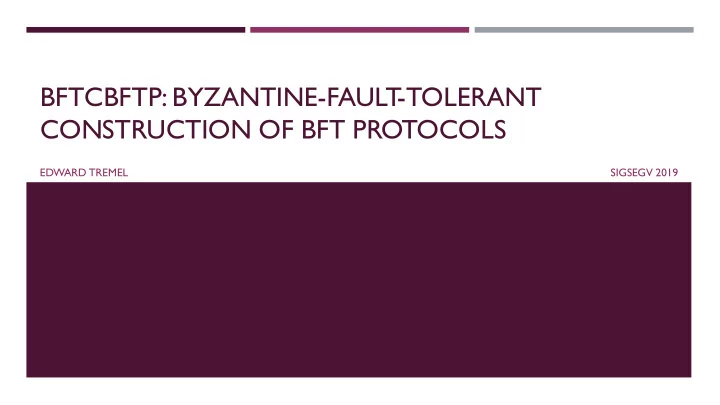

BFTCBFTP: BYZANTINE-FAULT -TOLERANT CONSTRUCTION OF BFT PROTOCOLS EDWARD TREMEL SIGSEGV 2019
BYZANTINE FAULT TOLERANCE Long-standing problem in systems Byzantine (adj): excessively complicated, and typically involving a great deal of administrative detail Inspired by bickering generals Assumes everyone is untrustworthy
BFT PROTOCOLS Need to be very complicated Much disagreement on how to construct them Necessary in order to make fault- tolerant systems Because we said so
PROBLEM: CONSTRUCTION OF NEW BFT PROTOCOLS Clearly, we always need more BFT protocols Constructing a BFT protocol takes a lot of work, hard for one researcher to do alone Distributing the work to multiple researchers would help, but systems researchers bicker more than Byzantine generals
SETUP 3f + 1 systems researchers Why? Because that’s the standard for BFT Mutually distrustful Must agree on details of protocol No “trusted third party” Solution can’t have a leader – everyone wants to be the leader Everyone has their own public/private key
PREREQUISITE: KEY EXCHANGE “Definitely 𝑄𝐿 𝑆 ” All BFT protocols depend on signing messages Bootstrapping problem: exchanging public keys when the network is untrusted ???? Our solution: Researchers meet IRL at a systems conference, give each other keys Body doubles impersonating researchers is out-of-scope for this work “Definitely 𝑄𝐿 𝑆 ”
PREREQUISITE: KEY EXCHANGE All BFT protocols depend on signing messages Bootstrapping problem: exchanging public keys when the network is untrusted Our solution: Researchers meet IRL at a systems conference, give each other keys Body doubles impersonating researchers is out-of-scope for this work
STEP 1: BROADCAST STEP 1 OF PROTOCOL Someone broadcasts their proposal for Step 1 of protocol, signed with their private key Whoever takes initiative gets to start
STEP 2: CRITICIZE STEP 1 OF PROTOCOL Each other researcher reads Step 1, writes criticism Append signed criticism to Step 1, broadcast to other researchers If anyone receives criticism with different Step 1, proof that author of Step 1 equivocated
STEP 3: HANDLE CRITICISM Author of Step 1, upon accumulating signed criticism from others, may revise step 1 in response If criticism is contradictory, may choose to reject If any criticism agrees, may begrudgingly accept * and apply to protocol * Sends out revised Step 1, with signed criticism appended, to prove authenticity of criticism Critics may detect equivocation by other researchers on their criticism at this point *
STEP 4: REBROADCAST REVISED STEP 1 * * Other researchers echo the revised * * * Step 1 to each other, to ensure author * is not equivocating
STEP 5: BROADCAST STEP 2 OF PROTOCOL * * Everyone who has an idea for Step 2 broadcasts it, appended to revised Step * * 1, signed with their key * Now we have to agree on whose idea * to use
STEP 6: VOTE ON STEP 2 Researchers sign and rebroadcast a * version of Step 2 if they agree to use it Once a version of Step 2 has signatures * from a majority, continue with it * * Decide whether to vote for a version * based on reputation system Vote for proposal if you like the researcher * who proposed it
STEP 7: CRITICIZE STEP 2 OF PROTOCOL Just like criticism on Step 1 Criticize version of Step 2 with majority votes
…AND SO ON * * * * * * * * * * *
EVERYBODY SENDS LOTS OF MESSAGES TO EVERYONE * * * * * * * * * * * * * * * * * * * * * * * * * * * * * *
HOPEFULLY THIS CONVERGES EVENTUALLY * * * * Everyone will get the same set of * * * * proposals, votes, criticism, etc. * * If enough researchers agree on each step, you can make progress But there’s no guarantee they will agree Oh well, BFT protocols aren’t live * * * * anyway * * * * * *
EVALUATION Number of BFT Protocols Published 10 Somehow, this usually works in practice 9 8 Many papers on BFT algorithms have 7 6 been written collaboratively 5 4 3 2 1 0 2014 2015 2016 2017 2018
I HOPE YOU DON’T HAVE ANY QUESTIONS
Recommend
More recommend